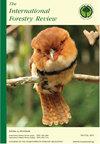Making Operational Plans Relevant to Forest User Groups in the Mid-Hills of Nepal
IF 0.9
4区 农林科学
Q2 FORESTRY
引用次数: 0
Abstract
HIGHLIGHTS Operational plans have presented identical sets of forest management objectives and activities irrespective of the varying biophysical and social contexts of their implementation. Collective management objectives of community forestry differ from the priorities of individual households in the rural communities. The contents of operational plans, which are designed to inform forest management decisions, are barely related to and poorly understood by local communities. Operational plans have received a symbolic value of forest ownership rather than being used as device to guide forest management operations. The plans need revision in their technical content in order to make them relevant to the capacity, priority and practices of forest management by local communities. SUMMARY Operational plans are a key element in community forestry in Nepal. However, the relevance of these plans to forest user groups (FUGs) is under scrutiny. This study investigates the usefulness of operational plans against the backdrop of knowledge, capacity and management practices of FUGs. Data were collected from 13 operational plans, 16 group discussions involving forestry professionals, and 218 household interviews in two villages of Lamjung district in Nepal. Whereas operational plans should specifically reflect site specific objectives and activities of forest management, the survey revealed identical objectives across the community forests. Current operational plans are technically complex, poorly linked to the place-based context of livelihood needs and less useful to the FUGs to inform and enhance forest management. This study proposes to differentiate community forests according to their production potentials, and revise the operational plans by shortening the elements that have little or no relevance to the FUGs.制定与尼泊尔中部山区森林用户群体相关的业务计划
亮点业务计划提出了一套相同的森林管理目标和活动,无论其执行的生物物理和社会背景如何。社区林业的集体管理目标不同于农村社区单个家庭的优先事项。旨在为森林管理决策提供信息的业务计划的内容与当地社区几乎没有关系,也很少为当地社区所了解。业务计划得到了森林所有权的象征性价值,而不是用作指导森林管理业务的手段。这些计划的技术内容需要修订,以使其与当地社区森林管理的能力、优先事项和做法相关。行动计划是尼泊尔社区林业的一个关键要素。然而,这些计划与森林用户群体的相关性正在受到审查。本研究在FUG的知识、能力和管理实践的背景下调查了运营计划的有用性。数据来自尼泊尔Lamjung区两个村庄的13个行动计划、16个涉及林业专业人员的小组讨论和218个家庭访谈。虽然业务计划应具体反映特定地点的森林管理目标和活动,但调查显示,整个社区森林的目标相同。目前的行动计划在技术上很复杂,与基于地方的生计需求联系不紧密,对FUG提供信息和加强森林管理的用处不大。本研究建议根据群落森林的生产潜力对其进行区分,并通过缩短与FUG几乎没有相关性或根本没有相关性的元素来修订运营计划。
本文章由计算机程序翻译,如有差异,请以英文原文为准。
求助全文
约1分钟内获得全文
求助全文
来源期刊

International Forestry Review
农林科学-林学
CiteScore
2.50
自引率
6.20%
发文量
29
审稿时长
>36 weeks
期刊介绍:
The International Forestry Review is a peer-reviewed scholarly journal that publishes original research and review papers on forest policy and science, with an emphasis on issues of transnational significance. It is published four times per year, in March, June, September and December. Special Issues are a regular feature and attract a wide audience. Click here for subscription details.
 求助内容:
求助内容: 应助结果提醒方式:
应助结果提醒方式:


